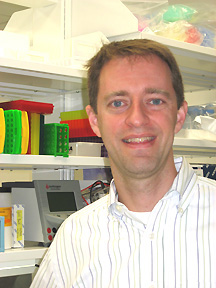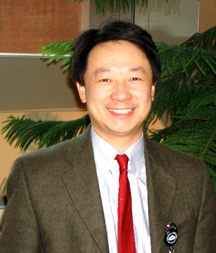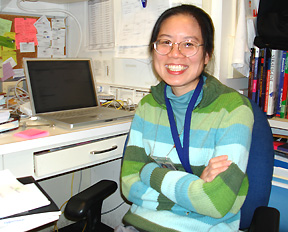
| T H E N I H C A T A L Y S T | J A N U A R Y – F E B R U A R Y 2008 |
|
|
|
ON TENURE TRACK |
|
 |
|
Chris
Buck
|
Virologist Chris Buck recently joined the Laboratory of Cellular Oncology (LCO) at NCI as an investigator, but he is a familiar face in Building 37. Buck did his postdoctoral training there, working under mentors John Schiller and Doug Lowy, and he is elated to be staying. "This is the best place in the world to do science," he says.
Buck’s interest in virology goes back to his graduate work on HIV with Robert Siciliano at the Johns Hopkins School of Medicine in Baltimore. His studies at NIH focus on human papillomaviruses (HPVs), a diverse family of more than 100 small DNA viruses that are tissue specific, living on epithelial surfaces like skin and mucous membranes.
These viruses are specially adapted to live in the relatively immune-privileged environment of the outer layers of the skin and are released by normal cell death at the skin surface.
Although some HPV types can cause skin warts, others are nearly commensal, causing either no symptoms or very benign symptoms. In a minority of cases, infection with some HPV types can progress to cancer, most notably cervical cancer.
A group of about a dozen "high-risk" HPV types cause nearly all cases of cervical cancer. Recently developed prophylactic HPV vaccines can protect against two of these types, which together cause about 75 percent of cervical cancer cases.
The diversity of the HPV family of viruses appears to be driven by their ability to escape from neutralizing antibodies raised against the capsid of another HPV type. However, the fact that diverse HPVs live in similar epithelial environments and appear to enter cells by similar pathways tells scientists like Buck that, despite the differences in the antibody recognition of these viruses, there are molecular patterns that all HPVs share—hidden structures on the surfaces of these viruses that are common to all HPVs. If an antibody response could be mounted against a conserved HPV antigen, then a broad range of HPV types could be neutralized.
Toward this goal, Buck is now studying the basic features of the virion structure. HPV is a nonenveloped virus; its capsid coat is a naked protein shell made of L1 proteins that are folded into an icosahedral structure.
Virologists now view viral entry into a cell as a dynamic process, says Buck. During entry, parts of the virus are coming and going as the virion twists and molds itself. At each step, conformational changes in the proteinaceous capsid structure reveal highly conserved motifs that are identical among a broad range of HPVs.
To begin his studies, Buck will use mass spectrometry to generate a basic "parts list" of cellular proteins that are incorporated into the HPV virion. Buck also hopes to use advanced mass spectrometric methods to reveal the motifs that may be exposed to the environment only transiently and to see the dynamic changes of the virion structure.
In addition to studying the infection processes, Buck is also interested in the assembly process, particularly in understanding how the viral DNA is captured and packaged in the capsid.
A tool Buck developed during his postdoc years aids all these studies: an HPV-based gene delivery vector that generates high yields of infectious virions. This technology mimics the entry and assembly pathways of HPV, allowing Buck to evaluate what proteins and conformational changes are required at each step in the pathways.
Other projects include collaborating with Barney Graham at NIAID’s Vaccine Research Center in pursuit of the possibility of using HPV-based vectors for genetic vaccination against other pathogens and helping to develop a clinical trial evaluating the ability of a common gelling agent found in vaginal lubricants, carrageenan, to protect against HPVs.
 |
|
King
Kwong |
King Kwong joined the Thoracic Oncology Section of the Surgery Branch, NCI, in September 2007. A cardiothoracic surgeon, Kwong was recruited from the University of Maryland School of Medicine (Baltimore) faculty, where he was active in both clinical and translational research of thoracic cancers. He will continue these activities at NIH, seeking to bring the results of his bench research to the care of clinical patients.
Most current modalities of cancer treatment, Kwong says, have not been able to capitalize on differences, such as those between normal cells and cancer cells, between different subtypes of the same cancer, or even between the same type of cancer in different patients. Molecular profiles of tumors from two patients with lung cancer, for example, may reveal widely disparate genetic or proteomic profiles.
Kwong’s laboratory is exploring targeted molecular therapies that focus on the changes that occur within apoptotic pathways that permit a normal cell to become a cancer cell. This research is an extension of work done in Kwong’s previous laboratory at the University of Maryland, where he and his research team had identified notable differences in the regulation of proteins involved in the apoptotic pathways of normal and lung cancer cells. As he explains, apoptosis pathways are highly conserved intracellular mechanisms found in all cells, including cancerous ones.
Here at NCI, Kwong’s group is pursuing experiments to determine how apoptosis is abnormally regulated in thoracic cancers. In addition, his laboratory is trying to determine whether inhibition of a group of proteins called IAPs (inhibitors of apoptosis) can either eliminate lung cancer cells outright or better sensitize them to other modes of cancer treatment.
A better understanding of the role of apoptosis in the establishment of lung cancer, Kwong believes, will guide the development of novel agents that manipulate the apoptotic pathway in favor of the cancer patient. These treatments might eliminate the cancer cells or render them more vulnerable to chemotherapy, radiation, or other existing molecular-targeted cancer treatments. Kwong hypothesizes that a multipronged molecular approach could, theoretically, convert even terminal metastatic disease into a chronic disease state in select cancer patients.
Basically, Kwong hopes to establish a more systematic understanding of lung cancer and other thoracic malignancies and to actively contribute–both at the bench and in the clinic–to improving the standards of clinical care, optimizing current therapies, and developing new ones.
 |
| Helen
Su |
Helen Su is an NIAID tenure-track clinical investigator, having participated in NIAID’s new Clinical Research Transition Program, an initiative providing opportunities for physicians to gain clinical and translational research experience in association with an NIAID laboratory.
She studies the human immune system, primarily through a protocol she developed involving patients with poorly characterized autoimmune disease and immunodeficiencies.
From 2002 until late 2006, Su worked first as a clinical fellow in allergy and immunology and later as an assistant clinical investigator under the mentorship of Michael Lenardo in the section on molecular development of the immune system in the Laboratory of Immunology, NIAID.
Su has a medical degree and doctorate from Brown University in Providence, R.I., where her research focused on host-virus interactions.
She became interested in the relationship between immunodeficiency and autoimmunity during her pediatric residency at St. Louis Children’s Hospital, where she saw what appeared to be healthy children suddenly consumed and killed by a hyperactive yet ineffectual immune response to normally innocuous pathogens.
As a clinical fellow at NIH, she studied patients with a variant of autoimmune lymphoproliferative syndrome called caspase-8 deficiency state (CEDS).
CEDS is characterized by autoimmunity and lymphocyte accumulation due to genetic mutations that interfere with the cell-death mechanism, as well as a profound immunodeficiency whose mechanism was previously unexplained.
In a 2005 Science article on which she was lead author, she and her colleagues reported how caspase-8, known to trigger apoptosis, also activates immune system cells via the gene transcription factor NF-kB (Science 307:1465–1468, 2005).
Su wants to understand the molecular mechanisms that regulate the human immune system and how their derangements cause disease.
The Clinical Center, she says, offers unparalleled access to a diverse patient population with similar immune disorders, as well as the resources to apply multiple methods—genetic, biochemical, and clinical—to plumb the causes of immune dysregulation.